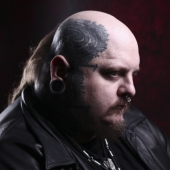Paul Booth (tattoo artist)
Paul Booth | |
|---|---|
 | |
| Known for | Tattoo artist |
| Website | www.lastrites.tv |
Paul Booth is a tattoo artist, sculptor, painter, filmmaker and musician living in New York City. Booth is known for his use of black and grey ink tattoo work depicting dark surrealism styled pieces. He has gained a cult-like following around the world and has had such celebrity clientele which include members of many rock bands such as Slipknot, Mudvayne, Slayer, Pantera, Soulfly, and Sepultura.[1]
Contents
1 Biography
2 Last Rites Tattoo Theater & Art Gallery
3 The Art Fusion Experiment
4 Filmmaking
5 References
6 External links
Biography
Booth’s artistic passion started when he was just a child. Completely self-taught, he always found comfort in painting darker and more monstrous subject matter. Through his own experimentation and personal growth, Booth has developed a technical style of his own. His utilization of a multi-layer approach, similar to that of the early Flemish painters, allows him to achieve a level of depth and texture that results in a visually stunning, realistic painting. Booth can be best described as a dark surrealist and has exhibited both domestically and internationally.
Booth is perhaps best known for his impact as a tattoo artist. When he got his first tattoo, his daughter's name, his interest was piqued and he wanted to learn more about what there was to the medium. Booth took the world of tattooing by storm with his formidable use of black and grey ink to depict demons, beasts, evil fetuses and other nightmare-worthy visuals. It wasn’t long until a cult following developed and swelled belly to include heavy metal rockers, actors, musicians and other purveyors of the dark aesthetic. Booth’s signature imagery graces the skin of many celebrities including Gregg Allman, The Undertaker, members of Slayer, Slipknot, Pantera, Lamb of God and many more. This following, along with his quintessential imagery has led Rolling Stone Magazine to dub Booth as “The New King of Rock Tattoos.”
In addition to introducing the darker side of art to tattooing, Booth has worked exceptionally hard to change the way the public views tattoo art. His strong efforts have and continue to elevate tattooing into the realm of fine art. Booth looks to skin as he does canvas, inks as paints, and utilizes the same approach and technique in all of his artwork. Through his unique artistic talent and ambitions for his industry, Booth has been recognized and inducted by the National Arts Club – the oldest and one of the most respected art institutions in the United States. He is the first tattoo artist to receive this honor.[2]
Last Rites Tattoo Theater & Art Gallery
In 1996, Booth opened up Last Rites Tattoo Theatre in New York City. With some of the finest tattoo artists in the world, Last Rites Tattoo Theatre quickly became one of the best studios to get inked and a legendary destination for fans and advocates of Booth’s dark empire. In 2007, Booth expanded his artistic and professional scope, and opened the first dark art gallery in NYC, aptly named Last Rites Gallery. Last Rites has since become a premier gallery for contemporary surrealism, hosting artists who are not afraid of exploring and dissecting every aspect of the human condition. Under one roof, Booth’s artistic passions coalesced and birthed a haven for those who resonate with darker aesthetics.
Last Rites Tattoo Theatre and Gallery provides its patrons with a sensory experience. Booth created an immersive world, first of its kind, in which guests can view the best of dark art, some of the best tattoo artists at work and an atmosphere unlike any other. Last Rites calls to the darkest depths of one’s psyche forward through its powerful visual repute and dark ideologies; No soul leaves the contemplative and moving environment unscathed.
The Art Fusion Experiment
In 2000, Paul Booth co-founded an international charitable art organization called Art Fusion Experiment (AFE).[3] This tattoo-centric art movement focuses its energy on a unique collaborative art concept and demonstrates the strength of the contemporary tattoo artist’s ability to work together as a community. This aspect of AFE allows artists to put their egos aside and collaboratively fuse their individual styles to achieve unequalled works of art. It also gives the artist the opportunity to be both a student and a teacher simultaneously. This unique nature of AFE provides artists from around the world a chance to work together to create a single piece.
Filmmaking
In 2007, Booth’s directorial debut, The ArtFusion Experiment had the honor of winning Best Feature Documentary at The Newport Beach Film Festival and continues to extend the reach and success of the movement he created. His second film, the experimental pseudo-documentary Paul Booth's Last Rites: Volume I deftly illustrates his unique twisted vision and reveals the sinister depth of his eclectic universe. The film provides not only a closer look into the process of Booth’s art but, more importantly, a glance into the lifestyles that surround him. Both films together share a juxtaposition that offers a glimpse into the mysterious mind of this enigmatic artist.
References
^ Lipton, Joshua (28 February 2002), "Bad Skin", Rolling Stone, retrieved 31 March 2010.mw-parser-output cite.citation{font-style:inherit}.mw-parser-output .citation q{quotes:"""""""'""'"}.mw-parser-output .citation .cs1-lock-free a{background:url("//upload.wikimedia.org/wikipedia/commons/thumb/6/65/Lock-green.svg/9px-Lock-green.svg.png")no-repeat;background-position:right .1em center}.mw-parser-output .citation .cs1-lock-limited a,.mw-parser-output .citation .cs1-lock-registration a{background:url("//upload.wikimedia.org/wikipedia/commons/thumb/d/d6/Lock-gray-alt-2.svg/9px-Lock-gray-alt-2.svg.png")no-repeat;background-position:right .1em center}.mw-parser-output .citation .cs1-lock-subscription a{background:url("//upload.wikimedia.org/wikipedia/commons/thumb/a/aa/Lock-red-alt-2.svg/9px-Lock-red-alt-2.svg.png")no-repeat;background-position:right .1em center}.mw-parser-output .cs1-subscription,.mw-parser-output .cs1-registration{color:#555}.mw-parser-output .cs1-subscription span,.mw-parser-output .cs1-registration span{border-bottom:1px dotted;cursor:help}.mw-parser-output .cs1-ws-icon a{background:url("//upload.wikimedia.org/wikipedia/commons/thumb/4/4c/Wikisource-logo.svg/12px-Wikisource-logo.svg.png")no-repeat;background-position:right .1em center}.mw-parser-output code.cs1-code{color:inherit;background:inherit;border:inherit;padding:inherit}.mw-parser-output .cs1-hidden-error{display:none;font-size:100%}.mw-parser-output .cs1-visible-error{font-size:100%}.mw-parser-output .cs1-maint{display:none;color:#33aa33;margin-left:0.3em}.mw-parser-output .cs1-subscription,.mw-parser-output .cs1-registration,.mw-parser-output .cs1-format{font-size:95%}.mw-parser-output .cs1-kern-left,.mw-parser-output .cs1-kern-wl-left{padding-left:0.2em}.mw-parser-output .cs1-kern-right,.mw-parser-output .cs1-kern-wl-right{padding-right:0.2em}
^ Hart, Carey; Palmer, Chris (2008). Inked. Artisan Books. ISBN 9781579653354.
^ Industry Five. "Paul Booth Interview". Prick Magazine. Archived from the original on 2009-04-22.
External links
| Wikimedia Commons has media related to Paul Booth. |
- Official website